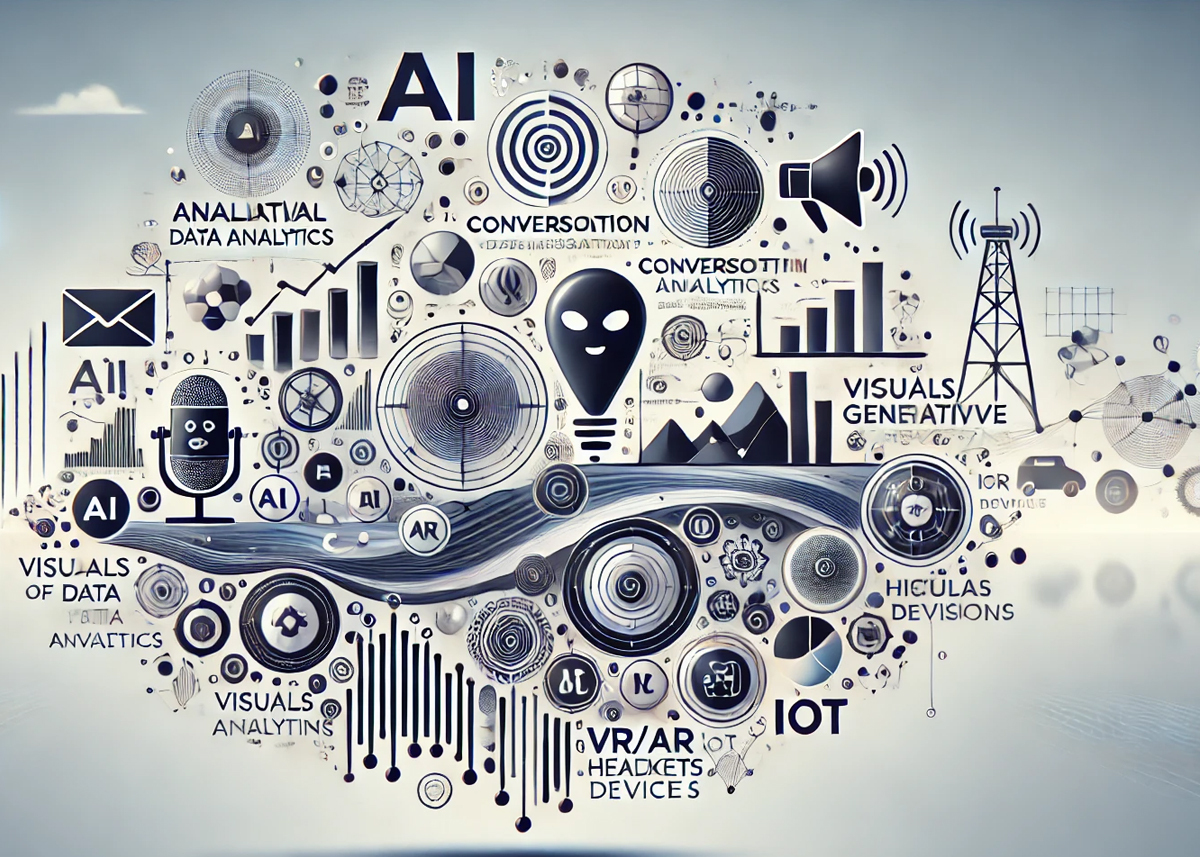Welcome to the AI Media Revolution
——
In today’s rapidly evolving digital landscape, Artificial Intelligence (AI) is revolutionizing the way brands approach media planning, buying, and analytics. This glossary serves as a comprehensive guide for media professionals to navigate the complex AI ecosystem, which is broadly categorized into four primary areas: Analytical, Conversational, Generative, and Hardware. Each category encompasses a variety of technologies that collectively enhance consumer experiences and optimize advertising strategies through data-driven, personalized approaches.
From machine learning’s predictive capabilities to the immersive experiences offered by virtual and augmented reality, these AI technologies are integral in crafting highly targeted, efficient, and impactful media campaigns. By understanding and leveraging these advancements, brands can stay ahead of the curve, meeting consumer demands with innovative solutions and achieving long-term growth in an ever-changing media planning and buying marketplace.
This guide aims to equip media professionals with the knowledge needed to effectively integrate AI into their strategies, ensuring they can harness the full potential of these cutting-edge tools. And more than likely AI is already incorporated into at least a portion of what you are already doing and you might not even realize it.
The Artificial Intelligence Landscape Consists of Four Primary Categories
1. Analytical
– Machine Learning
– Computer Vision
– Agent-Based Modeling
2. Conversational
– Natural Language Processing
– Conversational Systems
3. Generative
– Generative Pre-Trained Transformer (GPT)
– Generative Adversarial Network (GAN)
4. Hardware
– Virtual & Augmented Reality
– Edge Computing
– Internet of Things (IoT)

Analytical A.I.
Machine Learning
Machine Learning is a method of teaching computers to learn from data, without being explicitly programmed. It involves using algorithms to analyze and identify patterns in data, and then making predictions or decisions based on that data.
Machine learning enables brands to tailor content and ads to individual users through personalization, significantly increasing engagement and conversion rates. Advanced recommendation engines analyze user behavior to deliver personalized product suggestions, while prediction engines forecast future trends, helping brands allocate advertising budgets effectively. By anticipating market shifts, brands can adjust their strategies proactively. The integration of machine learning enhances customer experience, optimizes ad spend, and drives better business outcomes.
**Examples:**
– Personalization, recommendation, and prediction engines.
**Key Takeaway:**
– Embracing Machine Learning for personalized user experiences and data-driven predictions will enhance engagement and optimize advertising investments.
Computer Vision
Computer Vision enables machines to understand and interpret visual information from the world. It can be used for tasks such as object recognition, facial recognition, and image segmentation.
Computer vision enhances brands’ media strategies by enabling advanced image search, facial recognition, and dynamic ad insertion. Image search allows users to find products using images, improving the shopping experience. Facial recognition personalizes customer interactions and dynamic ad insertion uses real-time video analysis to increase ad effectiveness. This technology allows brands to create interactive and personalized media experiences, improving customer satisfaction and boosting marketing ROI.
**Examples:**
– Image search, facial recognition, dynamic ad insertion.
**Key Takeaway:**
– Utilizing Computer Vision to harness the power of visual data opens new avenues for immersive, real-time audience engagement.
Agent-Based Modeling
Agent-Based Modeling (ABM) is a simulation approach in which a model is built to represent the behavior of autonomous agents and the interactions between them. It’s used to study the behavior of complex systems by simulating the actions and interactions of the agents within a particular system.
Agent-based modeling allows brands to simulate interactions of individual agents, predicting complex system behaviors. ABM aids in scenario planning and epidemic modeling, helping brands understand potential outcomes of different media strategies. By modeling various advertising scenarios, brands can optimize media spend and adapt to market changes. This approach ensures media strategies are resilient and responsive.
**Examples:**
– Scenario Planning, epidemic modeling.
**Key Takeaway:**
– Utilizing ABM for strategic scenario planning and market anticipation leads to more informed and adaptable media strategies.

Conversational A.I.
Natural Language Processing
Natural Language Processing aims to analyze, understand, and generate human languages, allowing computers to process and make sense of large amounts of natural language data.
Natural Language Processing (NLP) enhances brands’ media strategies by enabling voice search, contextual targeting, and automatic translations. Voice search optimization helps brands remain competitive, while contextual targeting delivers more relevant ads. Automatic translations allow brands to reach a global audience. Integrating NLP improves targeting accuracy, expands reach, and enhances customer interactions.
**Examples:**
– Voice search, contextual targeting, automatic translations.
**Key Takeaway:**
– By implementing NLP, brands can enhance ad relevance, extend their global reach, and ensure effective communication with diverse audiences.
Conversational Systems
Conversational Systems are programs that can be integrated into various platforms such as websites, mobile apps, and messaging platforms that simulate conversation with humans.
Conversational systems, including chatbots, customer service agents, and digital assistants, enhance customer interaction and engagement. Chatbots provide instant responses, guide users, and offer personalized recommendations. AI-powered customer service agents handle complex queries, ensuring consistent support. Digital assistants facilitate hands-free interaction. These systems improve customer satisfaction and retention.
**Examples:**
– Chatbots, customer service agents, digital assistants.
**Key Takeaway:**
– Integrating conversational systems is essential for modernizing customer engagement and delivering efficient, personalized support.

Generative A.I.
Generative Pre-Trained Transformer (GPT)
Generative Pre-Trained Transformers are deep learning models that generate human-like text. A GPT is pre-trained on a large dataset of text, which allows it to understand the patterns and structure of human language. The model can be fine-tuned for a variety of natural language processing tasks.
GPTs can automate social and email copywriting, landing page creation, SEO tags, and website code. GPT generates high-quality content quickly, reducing time and cost. This technology enhances email campaigns, optimizes landing pages, and improves SEO performance. GPT allows brands to focus on strategic planning while automating routine tasks.
**Examples:**
– Social and email copywriting, landing page creation and SEO tags, website code.
**Key Takeaway:**
– Using GPTs for content creation streamlines processes, improves SEO, and allows a focus on strategic growth.
Generative Adversarial Networks (GAN)
A GAN is a model used to create new, previously unseen data similar to some known data. It consists of two components: a generator and a discriminator. The two networks are trained together where the generator tries to produce data that can fool the discriminator and the discriminator tries to identify the generated data as fake.
Generative Adversarial Networks (GANs) enable the creation of deepfakes, AI influencers, dynamic ad insertion, and video/audio content. GANs generate realistic synthetic content, enhancing marketing efforts. AI influencers promote products cost-effectively, while dynamic ad insertion tailors ads in real-time. GANs create personalized video/audio content, improving user experience.
**Examples:**
– Deepfakes, AI influencers, dynamic ad insertion, video and audio content creation.
**Key Takeaway:**
– Employing GANs to produce high-quality, customizable content increases engagement and marketing efficiency.

Hardware A.I.
Virtual and Augmented Reality
VR is a simulation of a 3D environment experienced through a headset. AR is a technology that overlays digital information, such as images, videos, or 3D models, on the user’s view of the real world.
Virtual and augmented reality (VR/AR) technologies, such as Oculus, QuestPro, and Rayban Stories, offer immersive and interactive experiences. Brands use VR to create virtual showrooms and AR for product visualization. These technologies enhance customer interaction and loyalty. By incorporating VR/AR, brands can create unique and memorable experiences, driving sales.
**Examples:**
– Oculus, QuestPro, Rayban Stories.
**Key Takeaway:**
– Incorporating VR/AR to offer immersive experiences significantly enhances customer engagement and loyalty.
Edge Computing
Edge Computing is a method of processing data where computation is performed on devices located near the source of data, rather than in a centralized data center or cloud. This allows for faster processing.
Edge computing processes data locally on devices like mobile phones and smart watches, improving speed and efficiency. This enables real-time data analysis, allowing brands to deliver personalized and context-aware content instantly. For example, real-time location-based advertising enhances relevance. Integrating edge computing improves campaign responsiveness and effectiveness.
**Examples:**
– Mobile phones, smart watches.
**Key Takeaway:**
– Harnessing edge computing for real-time, personalized content delivery boosts user experience and engagement.
Internet of Things (IoT)
The Internet of Things refers to “smart” devices and appliances that have the ability to collect and transfer data and are usually equipped with sensors, software, and network connectivity, allowing them to collect and share data.
The Internet of Things (IoT) leverages connected devices like Nest, Google Home, and Alexa to gather data on consumer behavior. Brands use this data for personalized content and offers. IoT devices also act as new advertising platforms. Integrating IoT creates more personalized experiences, driving customer loyalty and conversion rates.
**Examples:**
– Nest, Google Home, Alexa.
**Key Takeaway:**
– Utilizing IoT data to personalize content and reach consumers in their daily environments elevates targeting and engagement.




